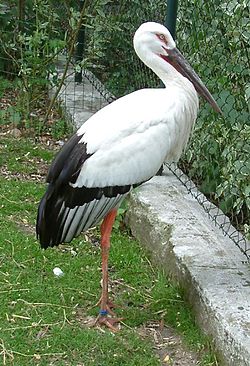鸛
| ||||||||
Translingual
Han character
鸛 (Kangxi radical 196, 鳥+18, 29 strokes, cangjie input 廿土竹日火 (TGHAF), four-corner 47227, composition ⿰雚鳥)
References
- Kangxi Dictionary: page 1504, character 39
- Dai Kanwa Jiten: character 47500
- Dae Jaweon: page 2034, character 11
- Hanyu Da Zidian (first edition): volume 7, page 4670, character 22
- Unihan data for U+9E1B
Chinese
| trad. | 鸛 | |
|---|---|---|
| simp. | 鹳 | |
| alternative forms | 雚 | |
Glyph origin
Phono-semantic compound (形聲/形声, OC *koːns) : phonetic 雚 (OC *koːns, “stork”) + semantic 鳥 (“bird”). Originally written 雚.
Pronunciation
- Mandarin
- (Standard Chinese)+
- Hanyu Pinyin:
- Zhuyin: ㄍㄨㄢˋ
- Tongyong Pinyin: guàn
- Wade–Giles: kuan4
- Yale: gwàn
- Gwoyeu Romatzyh: guann
- Palladius: гуань (guanʹ)
- Sinological IPA (key): /ku̯än⁵¹/
- (Standard Chinese)+
- Cantonese
- (Standard Cantonese, Guangzhou–Hong Kong)
- Jyutping: gun3
- Yale: gun
- Cantonese Pinyin: gun3
- Guangdong Romanization: gun3
- Sinological IPA (key): /kuːn³³/
- (Standard Cantonese, Guangzhou–Hong Kong)
- Southern Min
- Middle Chinese: kwanH
- Old Chinese
- (Baxter–Sagart): /*C.qʷˤar-s/
- (Zhengzhang): /*koːns/
Definitions
- stork
- crane (Grus japonensis)
- Used in 鵝鸛/鹅鹳 (éguàn).
Compounds
Lua error in Module:zh/templates at line 32: This template has been deprecated. Please use Template:col3 instead.
Japanese
Kanji
Readings
- Go-on: かん (kan)←くわん (kwan, historical)
- Kan-on: かん (kan)←くわん (kwan, historical)
- Kun: こうのとり (kōnotori, 鸛)←こふのとり (kofunotori, 鸛, historical)
Etymology 1
| Kanji in this term |
|---|
| 鸛 |
| こうのとり Hyōgai |
| kun'yomi |
Compound of 鸛 (kō, “Oriental stork(Please check if this is already defined at target. Replace {{vern}} with a regular link if already defined. Add novern=1 if not defined.)”, see below) + の (no, attributive particle) + 鳥 (tori, “bird”).
Pronunciation
Lua error in Module:parameters at line 828: Parameter "y" is not used by this template.
Noun
Lua error in Module:Jpan-headword at line 859: Parameter "hist1" has been entered more than once. This is probably because a list parameter has been entered without an index and with index 1 at the same time, or because a parameter alias has been used.
- the Oriental stork(Please check if this is already defined at target. Replace
{{vern}}with a regular link if already defined. Add novern=1 if not defined.), Ciconia boyciana- Synonym: 鸛鶴 (kōzuru)
- (by extension) any stork
Usage notes
As with many terms that name organisms, this term is often spelled in katakana, especially in biological contexts (where katakana is customary), as コウノトリ.
Etymology 2
| Kanji in this term |
|---|
| 鸛 |
| こう Hyōgai |
| kun'yomi |
/kan/ → /kau/ → /koː/
Pronunciation
Lua error in Module:parameters at line 828: Parameter "y" is not used by this template.
Noun
Lua error in Module:Jpan-headword at line 859: Parameter "hist1" has been entered more than once. This is probably because a list parameter has been entered without an index and with index 1 at the same time, or because a parameter alias has been used.
- the Oriental stork(Please check if this is already defined at target. Replace
{{vern}}with a regular link if already defined. Add novern=1 if not defined.), Ciconia boyciana
As with many terms that name organisms, this term is often spelled in katakana, especially in biological contexts (where katakana is customary), as コウ.
Derived terms
- 鸛鶴 (kōzuru)
- 青嘴鸛 (aohashikō, “white-bellied stork”)
- 朱嘴鸛 (akahashikō)
- 燕尾鸛 (enbikō, “maguari stork”)
- 鞍嘴鸛 (kurahashikō)
- 朱嘴鸛 (shubashikō, “white stork”)
- 白襟鸛 (shiroerikō, “wooy-necked stork”)
- 朱鷺鸛 (tokikō)
- 鍋鸛 (nabekō, “black stork”)
- 禿鸛 (hagekō)
- 嘴広鸛 (hashibirokō, “shoebill”)
References
Korean
Hanja
鸛 • (gwan) (hangeul 관, revised gwan, McCune–Reischauer kwan, Yale kwan)
Vietnamese
Han character
- This term needs a translation to English. Please help out and add a translation, then remove the text
{{rfdef}}.
- CJK Unified Ideographs block
- Han script characters
- Translingual lemmas
- Translingual symbols
- Han phono-semantic compounds
- Chinese lemmas
- Mandarin lemmas
- Cantonese lemmas
- Hokkien lemmas
- Middle Chinese lemmas
- Old Chinese lemmas
- Chinese hanzi
- Mandarin hanzi
- Cantonese hanzi
- Hokkien hanzi
- Middle Chinese hanzi
- Old Chinese hanzi
- Chinese nouns
- Mandarin nouns
- Cantonese nouns
- Hokkien nouns
- Middle Chinese nouns
- Old Chinese nouns
- Chinese terms with IPA pronunciation
- Chinese terms spelled with 鸛
- zh:Cranes (birds)
- Japanese kanji
- Japanese hyōgai kanji
- Japanese kanji with goon reading かん
- Japanese kanji with historical goon reading くわん
- Japanese kanji with kan'on reading かん
- Japanese kanji with historical kan'on reading くわん
- Japanese kanji with kun reading こうのとり
- Japanese kanji with historical kun reading こふのとり
- Japanese terms spelled with 鸛 read as こうのとり
- Japanese terms read with kun'yomi
- Japanese compound terms
- Japanese terms spelled with 鸛 read as こう
- ja:Storks
- Korean lemmas
- Korean hanja
- Vietnamese Chữ Hán
- Vietnamese lemmas
- Vietnamese Han characters

